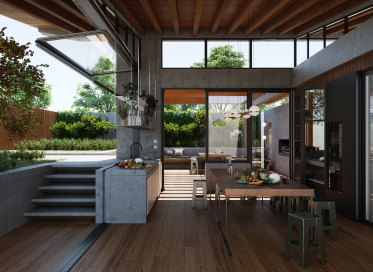
The JamFactory furniture collection, launched at DENFAIR 2016, was created to support local industry. Photograph by Sven Kovac.
Across its many disciplines the creative sector touches us all, from architecture to art and graphic design – we all benefit in some way from the pursuits of those with an idea and the ability to execute it.
A recent study into the economy of New Zealand showed that the creative sector contributes more to our southern neighbour’s GDP than agriculture, and is on par with the retail, food and beverage sectors. In fact, in 2016 design added over $10 billion to the nation's turnover and employed approximately 4.4% of the work force yet still, we wonder what the true value of design is.

Adam Goodrum's extensive Trace collection for Melbourne's Tait keeps everyone from welders to powder coaters in work.
Take a second to look around your home. Everything you own, including the bricks and mortar, has been designed by someone. It has been made by someone and it was sold by someone. Every purchase you make places you in an economic eco-system that supports people you may never meet but without a doubt – you know someone who benefits.
Some might equate the effect of design to trickle-down economics but, just like you, designers and architects are regular people with regular jobs and bills to pay, so let’s start with those creators and see how the creative economy generates ripples across our landscape rather than trickling down the social ladder.
It goes without saying, but every house in Australia was designed by someone. It is the law and, whether it was an architect or a draftsperson, the set of drawings the local council signs off have to be generated by someone who is trained to create them. There is at least one job created but it doesn’t stop there as those drawings need to be approved by them and then turned into a physical thing.

The Nau collection pictured here at DENFAIR 2017, features a number of Australian designers and supports local manufacturing.
Creating a home involves builders, concreters, electricians, plumbers, surveyors and engineers – just to name a few. All with lives and families of their own, supported by an idea and an investment.
Inside the walls of a home are objects – furniture, lighting, appliances and textiles. They all come from somewhere, designed and manufactured by people who don’t cry “struggling artist” but have to generate an income. It might sound obvious but that is only because you are thinking about it and isn’t just the aesthetic vision that keeps the wheels of industry in motion.
In recent years Australian furniture design has hit its stride through everyday objects, furniture and lighting and at the same time our manufacturing sector has taken a hit – particularly in the automotive sector. The Jam Factory in Adelaide identified this and decided to use their creative power and connections to do something about it, releasing a range designed by leading Australian designers and made by local industry. It was launched at Melbourne's DENFAIR, which in the past few years has become the place to discover Australian design of a world-standard.

The Lerod collection by Alexander Lotersztain is manufactured by a factory that make shopping trolleys.
So too did Brisbane-based Alexander Lotersztain with his Lerod chair. Having approached a local shopping trolley manufacturer to produce the chair, he was told they were too busy, though in the coming months the supermarket chains sent their contract to China. Now one of Lotersztain's best-selling pieces, the production process has inspired the factory staff and kept them in work.
It is becoming a common story – creativity supporting our economy and inspiring our communities – and with every decision we make it is worth considering who, aside from ourselves, will benefit from design in all its forms.
_
There are plenty of ways across Australia to explore the value of design – whether it is for you, your friends or your children.
Sydney: Hear how science and creativity come together during VIVID.
Adelaide: Visit JamFactory to experience design and making first-hand.
Canberra: Make your way to our nation’s capital for Canberra's Design Festival in November.
Melbourne: For an authentic taste of Australian and international design, register for DENFAIR at Melbourne’s Exhibition Centre this June.
Professional days: Thursday / Friday 14-15 June
Public day: Saturday 16 June
WRITTEN BY HouseLab









